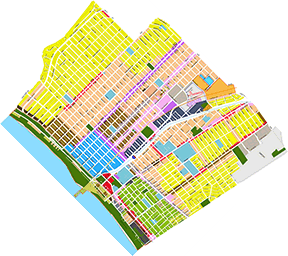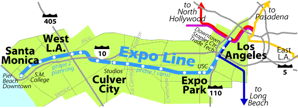Santa Monica
Councilmember Kevin McKeown
No other single change will affect Santa Monica’s future more than Expo Light Rail. Where’d we want the tracks?
What about residents, when Santa Monica is forced to accept an industrial rail yard
in our Pico neighborhood?
Many of us in Santa Monica feel overwhelmed by
chaotic changes that threaten to ruin the
character, livability, and affordability of our neighborhoods.
As Mayor in 2015, I led the Council in passing a new zoning code for the entire city that’s progressive without being excessive. Commercial growth will be contained, and creation of new housing will be focused in downtown, in previously industrial areas, and along mass transit corridors. This assures that we’ll maintain the scale and character of our existing neighborhoods we love. By making sure
transit serves new areas, we’ll cap traffic.
Residents riled about feared overdevelopment turn to their Councilmembers. I’m considered one of the most “slow-growth”, but for the first time in years we now have a progressive slow-growth majority. With the new zoning code
(Don’t forget that any TV set graphic on my website links to a video!)



Why would the Expo Authority put a maintenance facility next to people’s homes? Were the right criteria used?
Now that the regional Metro board has forced a rail yard on our Pico neighbors, how do we protect nearby families?
While better mass transit is a big part of our Santa Monica future, we must be wary of letting developers’ dreams get ahead of the reality. Too many “development agreements” jockeyed for early approval in the last several years, before the 2016 arrival of light rail. Santa Monica deserves true transit-oriented improvements, not merely transit-anticipatory development.
Dependable regional rail transit that takes cars off the road and guarantees mobility, no matter how gridlocked the freeway may become, is essential to our quality of life in Santa Monica. Without it, we risk becoming prisoners to Westside traffic. Every day Santa Monica swells from 90,000 to an estimated 250,000 people, and having fewer of those commuters come by car can only be good for those of us who live here and are tired of traffic.
Santa Monica was inappropriately blindsided by the Expo Line maintenance yard siting. A quasi-industrial facility immediately adjacent to a residential neighborhood simply showed up unheralded in an Expo Authority environmental impact document, with, tellingly, the Pico neighborhood edited out of the diagram. Clearly, the decision was made before we were even warned it was being considered, and the best we have been able to do on behalf of our residents is seek mitigations for the very considerable impacts. We can only hope the funding doesn't run out before the neighborhood protections are put in place and the “Buffer Park” is fully completed.
Santa Monica and all of the Westside need far more than Expo to restore access and mobility. The new Expo stations must become multimodal hubs for shuttle buses and bikeways. The eventual Subway to the Sea SHOULD come all the way to Santa Monica, and will be far from redundant; it will help remedy many decades of insufficient regional transit planning.
The document ruling future growth is the Land Use and Circulation Element, or LUCE, adopted in summer of 2010. Any plan that takes six and a half years to complete clearly involves lots of review and negotiation. I voted to adopt the final LUCE because, in the end, it contained far more consensus than compromise.
I was the only Council vote in 2010 against all the height increases, based on resident input to keep Santa Monica human-scaled. The last-minute changes of up to 11 feet made the height in one area greater than anywhere in the old 1984 general plan, after we were asked by the public to reduce heights. The good news is that in 2015 a new Council rolled back many heights in the new zoning code. Never forget that elections matter!
Traffic congestion is a major concern for Santa Monica, as is available affordable housing. I would have preferred a LUCE that more strongly favored residential uses over commercial uses, which can generate three times the traffic attributable to housing. The Council majority at the time overrode my motion to build more housing than commercial in the new "mixed-use creative" district. After the Hines proposal fiasco and referendum drive, our new Council has already asked to amend 2010’s LUCE, reducing commercial (and traffic) in the Bergamot Area, and favoring much-needed housing.

Taking a broad view of opportunities and challenges for the next twenty years or more, the LUCE is a visionary integration of land use, mobility, and sustainability. The new LUCE redirects development out of established neighborhoods, better protecting residents from evictions, demolitions, and relocations. That’s why, despite concerns about heights, and about commercial growth versus housing production, I voted for it. Now, with new colleagues who share my concerns and vision, we’re fixing the problems with the new zoning code and LUCE amendments.
Still to be determined is the zoning for Downtown Santa Monica, under what’s called the Downtown Specific Plan. We must learn from the previous Bergamont Area Plan. One of the questions we had to ask ourselves was whether individual Development Agreements should be negotiated before the full cumulative Environmental Impact Report was prepared. One such DA was a disaster.
The very first project in that new neighborhood that came to the City Council was for almost a million square feet at the corner right across from the future Bergamot Station of Expo light rail (see below). The developer was generous during the last election cycle, spreading almost $50,000 of donation largesse among five sitting Councilmembers (I was not one of them). Still, my motion to delay development negotiations, and send the project back till it better fits our LUCE, passed unanimously.
Don’t fence me in! Our new Expo light rail should integrate safely with a “complete street” down Colorado from 17th to 4th.
When we finally saw a revised project, it was still too big, too commercial, and too much of a traffic generator. Four of the seven Councilmembers went for it anyway. Over thirteen thousand voters signed a referendum petition, which stopped the project! We can and must negotiate for better proposals, and here are my published thoughts on that.




I’m honored by, and grateful for, your support in electing me six times!
Even our cherished oceanfront skyline is threatened by overdevelopment. Three proposals are pending for luxury condo/hotel towers along Ocean Avenue, one as much as 320 feet high. After the resident petition drive that stopped the Hines project, it’s clear these should go to the voters.

and the votes to enforce it, unwise oversized Development Agreements can be stopped.















